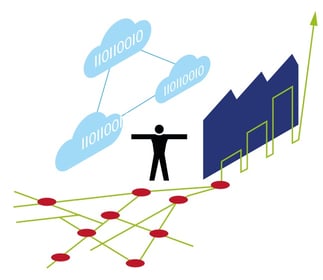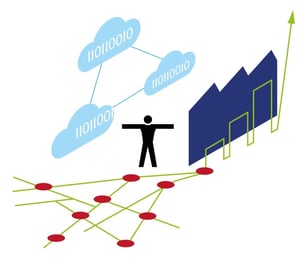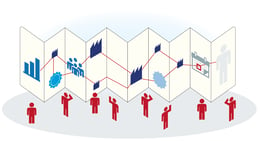5 Important Stats About Advanced Analytics
Jesse Kelber - December 24, 2019

 We’re surrounded by redundant expressions every day. Close proximity and basic fundamentals spring immediately to mind. Unintended mistake, past history, and plan ahead follow close behind. When hearing the phrase “advanced analytics,” many people jump to the conclusion that this is just another business-speak example of redundant word use. Aren’t all analytics advanced? In truth, the expression has a specific use, particularly in a discussion of data use in supply chain management.
We’re surrounded by redundant expressions every day. Close proximity and basic fundamentals spring immediately to mind. Unintended mistake, past history, and plan ahead follow close behind. When hearing the phrase “advanced analytics,” many people jump to the conclusion that this is just another business-speak example of redundant word use. Aren’t all analytics advanced? In truth, the expression has a specific use, particularly in a discussion of data use in supply chain management.
According to the MHI annual report for 2019, the use of advanced analytics in supply chain operations has skyrocketed in recent years, jumping from 17% in 2017 to 30% in 2019. That same report also states that the biggest hurdles supply chain managers are dealing with are (1) a lack of understanding on the part of company executives of the technology involved in the digital transformation; and (2) a lack of talent available to analyze the incoming data provided by this technology as it’s being implemented. This is all well and good, but it doesn’t answer the question, “How can advanced analytics support my supply chain management process?”
What We Mean By Advanced Analytics
Before we jump into our stats, let’s take a quick look at just what we mean when we say “advanced analytics.” At its most basic level, advanced analytics means taking data and turning it into insights. That is, gathering data from day-to-day operations of your supply chain, distilling it into usable nuggets of information, then putting these nuggets to use in guiding the decision-making process going forward. It’s the underlying technology that differentiates advanced analytics from older descriptive and/or diagnostic analytics. Many advanced analytics engines are using machine learning to increase the accuracy of predictions and improve the insights offered.
In action, it’s a bit more complicated. Industry analysis organization Gartner identifies three key types of advanced analytics:
- Predictive analytics—The insights that help ward off future disruptions before they happen.
- Prescriptive analytics—The insights that help determine future decisions and guide the company forward.
- Artificial Intelligence (AI): More of a blanket term for machine learning and other technology that powers the analytics engines providing the above insights.
For our purposes today, we’re going to be looking at statistics related to the first two, AI is a huge topic that we’ve addressed before and really requires entire posts to cover in detail. The above gives us a quick working definition of advanced analytics. We’ve collected the following five stats to help answer the remaining question: How they can help guide your decision process and move your supply chain into the 21st-century?
1) 57%: The Number of Supply Chain Managers Who Say their 5-Year Plan Includes Advanced Analytics
The same poll showed a paltry 30% who are actively putting insights from advanced analytics to use. These numbers mean big things for the future of analytics tools and solutions. Currently, early adopters are mostly using analytics engines to assist with inventory management. The insights gleaned from their historical use data helps inventory managers adjust where items are kept to speed up shipment load times, free up shelf space for other incoming orders, and speed order cycle time. With further maturation of the technology comes a wider use-case in every industry from healthcare to logistics and back again.
2) 62%: The Proportion of Supply Chain Disruptions Caused by Severe Weather Events in 2018
The use of advanced analytics in logistics is perhaps the area that holds the most promise for saving your company huge amounts of money and time. With over half of supply chain disruptions being caused by seemingly unpredictable weather events, insights into optimal shipping routes and times to send your goods around these events can save you millions. Logistics is often the first area of the value chain to feel disruptions of all sorts, hence the already wide-spread use of cutting edge IoT and AI technologies in this one area.
Combining historical weather data and current shipping patterns, advanced analytics can help you determine not only the optimal routes but even the best times of year for certain routes to be avoided. Going deeper into the technology, GPS tracking and smart pallets can provide real-time data to your supply chain management solution, allowing for immediate route changes when the unexpected happens.
3) 61%: How Many Managers Report Forecasting as the Single Most Important Inventory Management Practice
Demand forecasting is an integral part of any supply chain. And inventory managers report that it is growing in importance with the advent of direct-to-consumer sales and production-on-demand technologies being incorporated into the chain. So if you’re looking for a place to begin your advanced analytics deployment, look no farther than your own demand forecasting process. The ability to parse historical sales data and combine it with the real-time data being collected by your analytics engine is step one. Step two is to combine data from point-of-sale devices, IoT sensors on the factory floor monitoring production levels, or trackers on incoming shipments of supplies; this combination of technology is of the utmost importance for accurate forecasting. And accurate forecasts are the #1 way to drastically reduce your inventory carry costs.
4) 50%: The Number of Companies Who Say Technology has a Strong Impact on Their Supply Chain
This is encouraging for everyone considering rolling out their own IoT sensors and analytics engines. Fully half of the companies polled report that the biggest impact on their supply chains in recent years has been the adoption of emerging technologies. The advanced analytics these technologies empower are the real keys to reshaping your end-to-end supply chain. IoT sensors, IT infrastructure, and skilled data analysts are but a few of the necessary pieces to the puzzle that is the digital transformation of your supply chain.
5) 69%: The Percentage of Supply Chain Managers Who Say They Do Not Have Complete Visibility into Their Own Chains
Supply chain visibility is the single most important goal for supply chain managers in the coming years. Each and every implementation of Industry 4.0 technologies brings this goal one step closer to realization. Those polled identify this as the #1 technical stumbling block on the road to advanced analytics implementation. According to this same poll, a minuscule 6% of supply chain managers said they had 100% visibility. Those with complete visibility report more accurate forecasting, better communication between value chain stakeholders, and clearer expectations for up and downstream partners as just a few of the benefits of a high level of supply chain visibility.
LATEST POSTS
- Understand Circular Economy in The Manufacturing Industry
- How Can Industry 4.0 IT Integration Be Achieved Smoothly?
- The Significance of Order Sequencing in Discrete Manufacturing
- How to improve your Supply Chain Management: The Power of Control Towers
- Optimizing Human Resource Scheduling in Manufacturing: A Technological Approach



